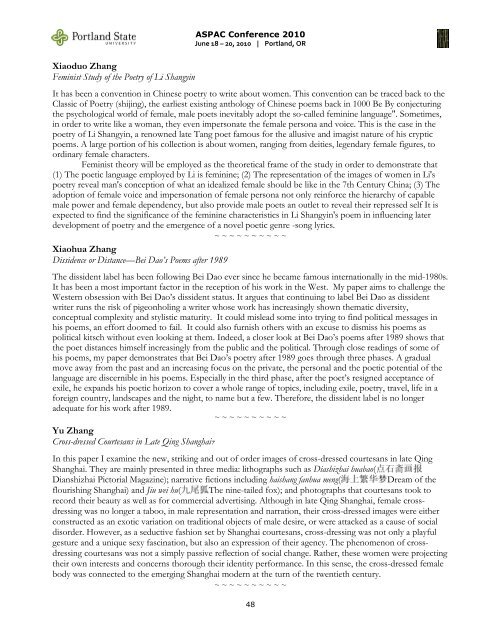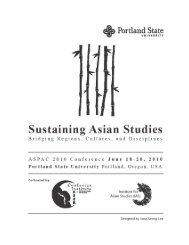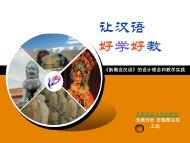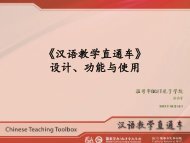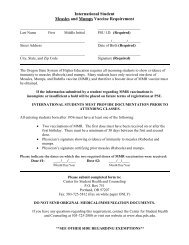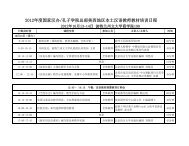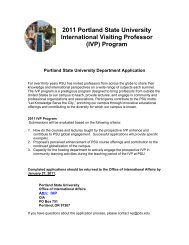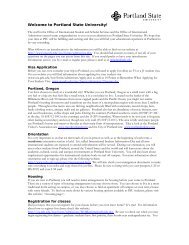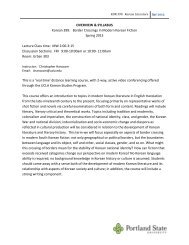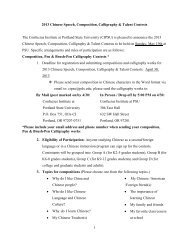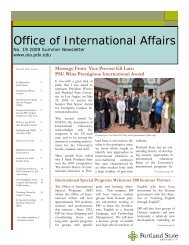ABSTRACTS - oia - Portland State University
ABSTRACTS - oia - Portland State University
ABSTRACTS - oia - Portland State University
You also want an ePaper? Increase the reach of your titles
YUMPU automatically turns print PDFs into web optimized ePapers that Google loves.
Xiaoduo Zhang<br />
Feminist Study of the Poetry of Li Shangyin<br />
ASPAC Conference 2010<br />
June 18 – 20, 2010 | <strong>Portland</strong>, OR<br />
It has been a convention in Chinese poetry to write about women. This convention can be traced back to the<br />
Classic of Poetry (shijing), the earliest existing anthology of Chinese poems back in 1000 Be By conjecturing<br />
the psychological world of female, male poets inevitably adopt the so-called feminine language". Sometimes,<br />
in order to write like a woman, they even impersonate the female persona and voice. This is the case in the<br />
poetry of Li Shangyin, a renowned late Tang poet famous for the allusive and imagist nature of his cryptic<br />
poems. A large portion of his collection is about women, ranging from deities, legendary female figures, to<br />
ordinary female characters.<br />
Feminist theory will be employed as the theoretical frame of the study in order to demonstrate that<br />
(1) The poetic language employed by Li is feminine; (2) The representation of the images of women in Li's<br />
poetry reveal man's conception of what an idealized female should be like in the 7th Century China; (3) The<br />
adoption of female voice and impersonation of female persona not only reinforce the hierarchy of capable<br />
male power and female dependency, but also provide male poets an outlet to reveal their repressed self It is<br />
expected to find the significance of the feminine characteristics in Li Shangyin's poem in influencing later<br />
development of poetry and the emergence of a novel poetic genre -song lyrics.<br />
~ ~ ~ ~ ~ ~ ~ ~ ~ ~<br />
Xiaohua Zhang<br />
Dissidence or Distance—Bei Dao’s Poems after 1989<br />
The dissident label has been following Bei Dao ever since he became famous internationally in the mid-1980s.<br />
It has been a most important factor in the reception of his work in the West. My paper aims to challenge the<br />
Western obsession with Bei Dao’s dissident status. It argues that continuing to label Bei Dao as dissident<br />
writer runs the risk of pigeonholing a writer whose work has increasingly shown thematic diversity,<br />
conceptual complexity and stylistic maturity. It could mislead some into trying to find political messages in<br />
his poems, an effort doomed to fail. It could also furnish others with an excuse to dismiss his poems as<br />
political kitsch without even looking at them. Indeed, a closer look at Bei Dao’s poems after 1989 shows that<br />
the poet distances himself increasingly from the public and the political. Through close readings of some of<br />
his poems, my paper demonstrates that Bei Dao’s poetry after 1989 goes through three phases. A gradual<br />
move away from the past and an increasing focus on the private, the personal and the poetic potential of the<br />
language are discernible in his poems. Especially in the third phase, after the poet’s resigned acceptance of<br />
exile, he expands his poetic horizon to cover a whole range of topics, including exile, poetry, travel, life in a<br />
foreign country, landscapes and the night, to name but a few. Therefore, the dissident label is no longer<br />
adequate for his work after 1989.<br />
~ ~ ~ ~ ~ ~ ~ ~ ~ ~<br />
Yu Zhang<br />
Cross-dressed Courtesans in Late Qing Shanghai7<br />
In this paper I examine the new, striking and out of order images of cross-dressed courtesans in late Qing<br />
Shanghai. They are mainly presented in three media: lithographs such as Diashizhai huabao(点石斋画报<br />
Dianshizhai Pictorial Magazine); narrative fictions including haishang fanhua meng(海上繁华梦Dream of the<br />
flourishing Shanghai) and Jiu wei hu(九尾狐The nine-tailed fox); and photographs that courtesans took to<br />
record their beauty as well as for commercial advertising. Although in late Qing Shanghai, female crossdressing<br />
was no longer a taboo, in male representation and narration, their cross-dressed images were either<br />
constructed as an exotic variation on traditional objects of male desire, or were attacked as a cause of social<br />
disorder. However, as a seductive fashion set by Shanghai courtesans, cross-dressing was not only a playful<br />
gesture and a unique sexy fascination, but also an expression of their agency. The phenomenon of crossdressing<br />
courtesans was not a simply passive reflection of social change. Rather, these women were projecting<br />
their own interests and concerns thorough their identity performance. In this sense, the cross-dressed female<br />
body was connected to the emerging Shanghai modern at the turn of the twentieth century.<br />
~ ~ ~ ~ ~ ~ ~ ~ ~ ~<br />
48


